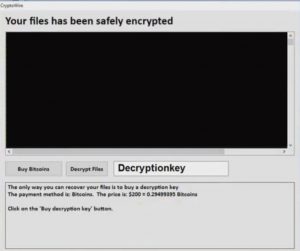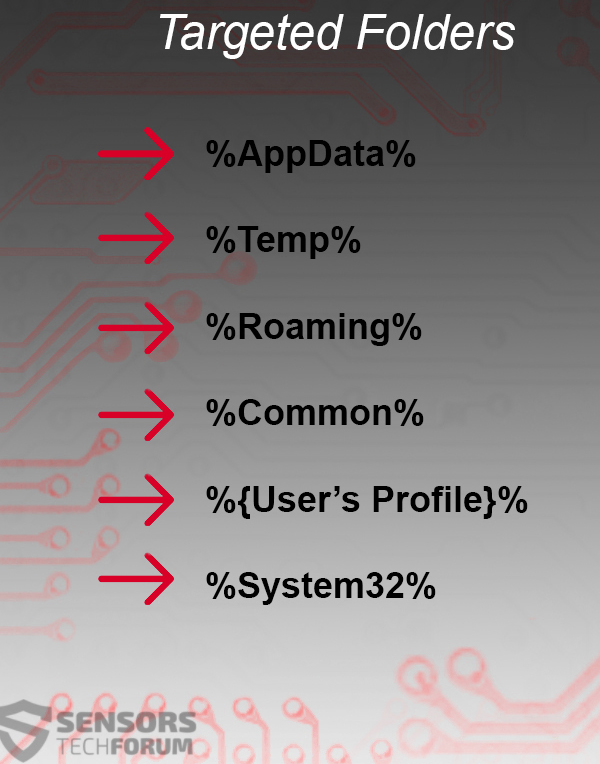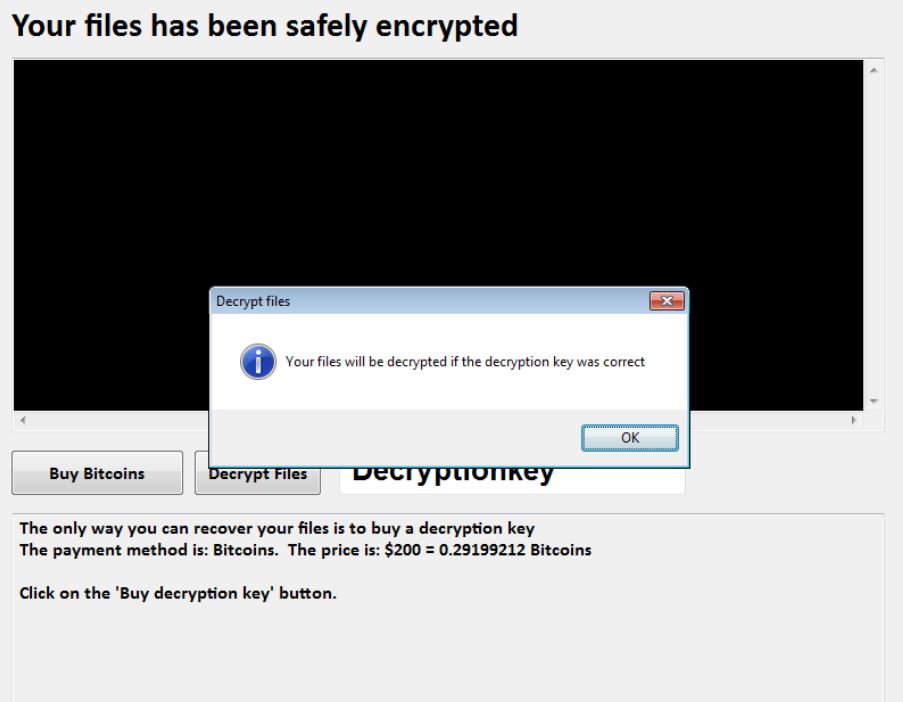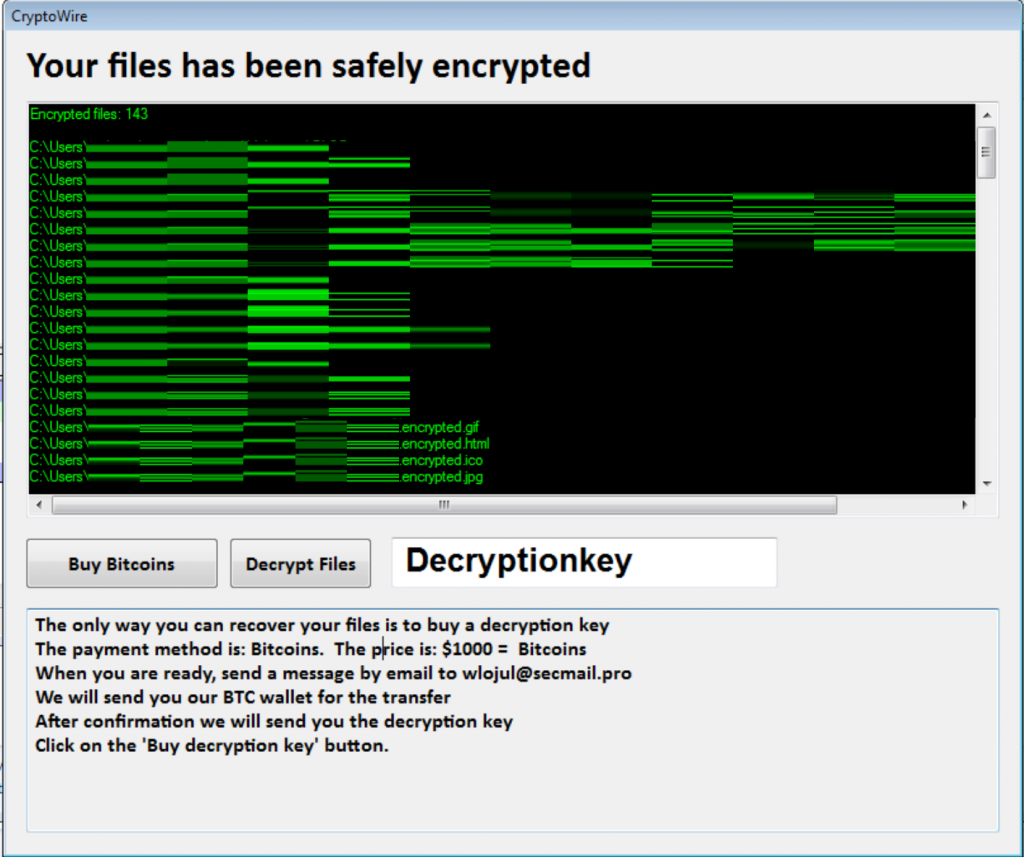 Ransowmare virus, going by the name CryptoWire has been reported to cause infections and encrypt files of affected comptuers by appending the .encrypted file extension after that. The virus uses AES encryption algorithm to encipher the files of its victims rendering them no longer openable. It also leaves a lockscreen in addition to the encryption where the demands are to pay approximately 0.29 BTC in ransom by buying decryption keys via pressing a button. Anyone who has become victim of the CrytoWire ransomware are strongly advised to not pay the ransom and follow the information in this article to help you learn more about the virus, remove it and hopefully restore your files.
Ransowmare virus, going by the name CryptoWire has been reported to cause infections and encrypt files of affected comptuers by appending the .encrypted file extension after that. The virus uses AES encryption algorithm to encipher the files of its victims rendering them no longer openable. It also leaves a lockscreen in addition to the encryption where the demands are to pay approximately 0.29 BTC in ransom by buying decryption keys via pressing a button. Anyone who has become victim of the CrytoWire ransomware are strongly advised to not pay the ransom and follow the information in this article to help you learn more about the virus, remove it and hopefully restore your files.

Threat Summary
| Name | CryptoWire |
| Type | Ransomware |
| Short Description | The ransomware encrypts files with the AES ciphers and asks a ransom payoff for decryption. |
| Symptoms | Files are encrypted and become inaccessible. A ransom note with instructions for paying the ransom shows as a lockscreen. |
| Distribution Method | Spam Emails, Email Attachments, File Sharing Networks. |
| Detection Tool |
See If Your System Has Been Affected by malware
Download
Malware Removal Tool
|
| Data Recovery Tool | Windows Data Recovery by Stellar Phoenix Notice! This product scans your drive sectors to recover lost files and it may not recover 100% of the encrypted files, but only few of them, depending on the situation and whether or not you have reformatted your drive. |

CryptoWire Ransom Virus – Distribution Vectors
Similar to other crypto-viruses, the CryptoWire threat could use the following tools to help it cause successful infections:
- Malicious JavaScript (URLs or .wsf, .js type of files in attachments)
- Malicious HTML files (.html, .htm, .hta and others)
- Malware obfuscators that hide the malware from any security software on the victim computer.
- File Joiners that may combine the virus with legitimate documents, such as Microsoft Office documents or Adobe documents containing malicious macros.
- Malicious servers (for command and control and the download of the payload).
- Tools used to help the virus spread via different spam, also known as spam bots.
- External spamming services of other cyber-crooks as a form of collaboration.
These tools may successfully spread CryptoWire on your e-mail, your social media accounts and even as comments on forums, like reddit and others. Sometimes spam bots may be used to take over Facebook accounts , create duplicate accounts or other devious activities and spam the virus via posts or messages this way. Whatever the case may be, once you open CryptoWire’s malicious payload, you become “cryptowired” and so far there seems to be no turning back.

CryptoWire Ransomware – Technical Analysis
The virus interestingly enough uses a combination of lockscreen techniques as well as techniques that directly cause file encryption via the AES encryption algorithm which is one of the strongest publicly available. The encryption is originally designed for military defensive purposes when it comes down to classified files and depending on how strong it is lies the outcome of the decryption of your data.
After infection by CryptoWire, the virus may download it’s payload via several different names, but most researchers who detected it know its malicious file to be named completely randomly with the following technical information about it:
→Filename
5684f8b6422ec02116b5ae28480756005e58cd4cfc5701d94fa180ea06de96d6
Size
874KiB (894464 bytes)
Type
PE32 executable (GUI) Intel 80386, for MS Windows
Architecture
32 Bit
SHA256
5684f8b6422ec02116b5ae28480756005e58cd4cfc5701d94fa180ea06de96d6Copy
Source: hybrid-analysis.com
The malicious files belonging to CryptoWire may be located In several key Windows folders:
After executed, the malicious file of CryptWire immediately begins malicious process injection in key Windows processes:
- schtasks.exe
- vssadmin.exe
- bcedit.exe
- cmd.exe
- rundll32.exe
It may use those key Windows modules for different malicious activities:
- To communicate online with the C&C(Command and Control) servers of the cyber-criminals.
- To execute the privileged vssadmin command in “/quiet” mode and delete all shadow volume copies of the infected computer.
- To heavily modify subkeys and add custom values in the Windows Registry Editor. These may be used to lock the screen and run on system startup before any protection software blocks it while it encrypts user data.
After the module which is responsible for encrypting files is ran, it may immediately attack types of files that are used very often, like videos, images, audio files, databases and others. We have summed up commonly used file extensions to give you a vague overview of what file extensions this virus may be pre-programmed to encipher:
→“PNG .PSD .PSPIMAGE .TGA .THM .TIF .TIFF .YUV .AI .EPS .PS .SVG .INDD .PCT .PDF .XLR .XLS .XLSX .ACCDB .DB .DBF .MDB .PDB .SQL .APK .APP .BAT .CGI .COM .EXE .GADGET .JAR .PIF .WSF .DEM .GAM .NES .ROM .SAV CAD Files .DWG .DXF GIS Files .GPX .KML .KMZ .ASP .ASPX .CER .CFM .CSR .CSS .HTM .HTML .JS .JSP .PHP .RSS .XHTML. DOC .DOCX .LOG .MSG .ODT .PAGES .RTF .TEX .TXT .WPD .WPS .CSV .DAT .GED .KEY .KEYCHAIN .PPS .PPT .PPTX ..INI .PRF Encoded Files .HQX .MIM .UUE .7Z .CBR .DEB .GZ .PKG .RAR .RPM .SITX .TAR.GZ .ZIP .ZIPX .BIN .CUE .DMG .ISO .MDF .TOAST .VCD SDF .TAR .TAX2014 .TAX2015 .VCF .XML Audio Files .AIF .IFF .M3U .M4A .MID .MP3 .MPA .WAV .WMA Video Files .3G2 .3GP .ASF .AVI .FLV .M4V .MOV .MP4 .MPG .RM .SRT .SWF .VOB .WMV 3D .3DM .3DS .MAX .OBJ R.BMP .DDS .GIF .JPG ..CRX .PLUGIN .FNT .FON .OTF .TTF .CAB .CPL .CUR .DESKTHEMEPACK .DLL .DMP .DRV .ICNS .ICO .LNK .SYS .CFG” Source:fileinfo.com
After the encryption process by CryptWire has completed, the virus begins to immediately lock the screen of the user PC and display it’s unique message:
The virus even has a button that leads directly to a Bitcoin trading platform where victims will be able to buy BTC, making it more convenient.
The worse news about CryptoWire, however are not related either to the AES-256 algorithm It uses neither to the fact that it uses lockscreen messages. They are related to the fact that the virus has been uploaded directly for free with all of it’s “features” advertised in GitHub which may be an opportunity for coders who want to create their own variant of CryptoWire. Here are some of the extras being advertised:
- Encrypts files on stored USB drives, other external drives, OneDrive, Dropbox, Google Drive (cloud services), Google Games(Steam), Network shares.
- Not specifically extension based, encrypts all files besides critical Windows files that are maximum 30 MB in size.
- Deletes shadow volume copies.
- Overwrites old versions of the files which are non-encrypted several times, 10 to be prices to make them permanently deleted and unable to be recovered by any type of data recovery software.
- Avoids heuristic scans using custom algorithms.
- Runs on startup.
- Checks the domain of the victim PC and if the computer is an eneterprise machine belonging to a business network the ransom payoff amount significantly rises ten times.

April 2018 New CryptoWire Release
Even though the CryptoWire ransomware family is not among the most advanced ones it is frequently used by beginner malware actors against users worldwide. A recent active attack campaign bearing its signatures was detected in April 2018, the analysis reveals that the virus payload is a customized version of the main version. The strain is compiled on April 10 2018 and shortly after that we have received reports of infected users.
By following the already established behavior patterns the virus engine proceeds into certain system modifications that make it more difficult to restore the affected system and data:
- Shadow Volume Copies Removal — The malware engine has the ability to remove all found shadow volume copies of the victim data. The impacted files can be restored with a quality recovery software. Refer to our instructions below.
- Boot Options Modification — The CryptoWire malware engine modifies the boot options thereby removing the possibility to boot into the recovery menu.
- Persistent State of Execution — CryptoWire creates a scheduled task that executes the virus every time the computer boots.
The captured samples have been found to affect the following file type extensions:
3fr, 7z, EPS, M3U, M4A, PEM, PSD, WPS, XLSX, abw, accdb, afsnit, ai, aif, arc, arw, as, asc, asd, asf,
ashdisc, asm, asp, aspx, asx, aup, avi, bay, bbb, bdb, bibtex, bkf, bmp, bmp, bpn, btd, bz2, c, cdi, cdr,
cer, cert, cfm, cgi, cpio, cpp, cr2, crt, crw, csr, cue, dbf, dcr, dds, dem, der, dmg, dng, doc, docm, docx, dsb,
dwg, dxf, dxg, eddx, edoc, eml, emlx, eps, epub, erf, fdf, ffu, flv, gam, gcode, gho, gpx, gz, h, hbk, hdd, hds,
himmel, hpp, ics, idml, iff, img, indd, ipd, iso, isz, iwa, j2k, jp2, jpeg, jpf, jpg, jpm, jpx, jsp, jspa, jspx,
jst, kdc, key, keynote, kml, kmz, lic, lwp, lzma, m4v, max, mbox, md2, mdb, mdbackup, mddata, mdf, mdinfo, mds,
mef, mid, mov, mp3, mp4, mpa, mpb, mpeg, mpg, mpj, mpp, mrw, msg, mso, nba, nbf, nbi, nbu, nbz, nco, nef, nes,
note, nrg, nri, nrw, odb, odc, odm, odp, ods, odt, ogg, one, orf, ova, ovf, oxps, p12, p2i, p65, p7, p7b, p7c,
pages, pct, pdd, pdf, pef, pem, pfx, php, php3, php4, php5, phps, phpx, phpxx, phtm, phtml, pl, plist, pmd, pmx,
png, ppdf, pps, ppsm, ppsx, ppt, pptm, pptx, ps, psd, pspimage, pst, ptx, pub, pvm, qcn, qcow, qcow2, qt, r3d, ra,
raf, rar, raw, rm, rtf, rtf, rw2, rwl, s, sbf, set, skb, slf, sme, smm, snp, spb, sql, sr2, srf, srt, srw, ssc, ssi,
stg, stl, svg, swf, sxw, syncdb, tager, tc, tex, tga, thm, tif, tiff, til, toast, torrent, txt, vbk, vcard, vcd, vcf,
vdi, vfs4, vhd, vhdx, vmdk, vob, vsdx, wav, wb2, wbk, wbverify, webm, wmb, wpb, wpd, wps, x3f, xdw, xlk, xlr, xls, xlsb,
xlsm, xlsx, xz, yuv, zip, zipx
As a consequence all affected data is renamed with the .encrypted extension. Like some of its previous versions this particular sample launches an application-based lockscreen with the “CryptoWire” title. It reads the following message:
The only way you can recover your files is to buy a decryption key
The payment method is: Bitcoins. The price is: $1000 = Bitcoins
When you are ready, send a message by email to wlojul@secmail.pro
We will send you our BTC wallet for the transfer
After confirmation we will send you the decryption key
Click on the ‘Buy decryption key’ button.

CryptoWire Ransomware – The Bottom Line, Removal and How to Restore the Files
In conclusion, this is a very ambitious ransomware project, that not only has evasive techniques but may also prove to be well coded as well. With the source code being released into the open on GitHub, many opportunist blackhats may take advantage of the malware and begin infecting users with their own variants of it. Malware researchers, however are also aware of the virus and are working on methods to decrypt it by reverse engineering it’s code. This is the primary reason we recommend not paying the ransoma and focusing on removing the ransomware yourself while waiting for a decryptor for your files.
In case you feel convinced that CryptoWire malware must go(recommended), we advise you to follow the instructions below and hunt for it’s malicious files and other objects in Windows Safe Mode. Security experts always advise that the best method to fully remove viruses like CryptoWire is to use an advanced anti-malware program, instructions for which we have posted below as well. This will allow for the automatic detection off all the CryptoWire objects and other malware it may have slithered onto your system as well.
Furthermore, even though restoring files encriphered by CryptoWire may not be easy, we still advise you to try the alternative methods in step “2. Restore files encrypted by CryptoWire” below. They are not guarantee of successful file reversing but they are the best temporary alternative to choose from while a free decryptor is released. When free decryptor is released, we will post instructions on our blog and post a web link in this article for you to see and recover your files for free.
- Step 1
- Step 2
- Step 3
- Step 4
- Step 5
Step 1: Scan for CryptoWire with SpyHunter Anti-Malware Tool



Ransomware Automatic Removal - Video Guide
Step 2: Uninstall CryptoWire and related malware from Windows
Here is a method in few easy steps that should be able to uninstall most programs. No matter if you are using Windows 10, 8, 7, Vista or XP, those steps will get the job done. Dragging the program or its folder to the recycle bin can be a very bad decision. If you do that, bits and pieces of the program are left behind, and that can lead to unstable work of your PC, errors with the file type associations and other unpleasant activities. The proper way to get a program off your computer is to Uninstall it. To do that:


 Follow the instructions above and you will successfully delete most unwanted and malicious programs.
Follow the instructions above and you will successfully delete most unwanted and malicious programs.
Step 3: Clean any registries, created by CryptoWire on your computer.
The usually targeted registries of Windows machines are the following:
- HKEY_LOCAL_MACHINE\Software\Microsoft\Windows\CurrentVersion\Run
- HKEY_CURRENT_USER\Software\Microsoft\Windows\CurrentVersion\Run
- HKEY_LOCAL_MACHINE\Software\Microsoft\Windows\CurrentVersion\RunOnce
- HKEY_CURRENT_USER\Software\Microsoft\Windows\CurrentVersion\RunOnce
You can access them by opening the Windows registry editor and deleting any values, created by CryptoWire there. This can happen by following the steps underneath:


 Tip: To find a virus-created value, you can right-click on it and click "Modify" to see which file it is set to run. If this is the virus file location, remove the value.
Tip: To find a virus-created value, you can right-click on it and click "Modify" to see which file it is set to run. If this is the virus file location, remove the value.
Before starting "Step 4", please boot back into Normal mode, in case you are currently in Safe Mode.
This will enable you to install and use SpyHunter 5 successfully.
Step 4: Boot Your PC In Safe Mode to isolate and remove CryptoWire





Step 5: Try to Restore Files Encrypted by CryptoWire.
Method 1: Use STOP Decrypter by Emsisoft.
Not all variants of this ransomware can be decrypted for free, but we have added the decryptor used by researchers that is often updated with the variants which become eventually decrypted. You can try and decrypt your files using the instructions below, but if they do not work, then unfortunately your variant of the ransomware virus is not decryptable.
Follow the instructions below to use the Emsisoft decrypter and decrypt your files for free. You can download the Emsisoft decryption tool linked here and then follow the steps provided below:
1 Right-click on the decrypter and click on Run as Administrator as shown below:

2. Agree with the license terms:

3. Click on "Add Folder" and then add the folders where you want files decrypted as shown underneath:

4. Click on "Decrypt" and wait for your files to be decoded.

Note: Credit for the decryptor goes to Emsisoft researchers who have made the breakthrough with this virus.
Method 2: Use data recovery software
Ransomware infections and CryptoWire aim to encrypt your files using an encryption algorithm which may be very difficult to decrypt. This is why we have suggested a data recovery method that may help you go around direct decryption and try to restore your files. Bear in mind that this method may not be 100% effective but may also help you a little or a lot in different situations.
Simply click on the link and on the website menus on the top, choose Data Recovery - Data Recovery Wizard for Windows or Mac (depending on your OS), and then download and run the tool.
CryptoWire-FAQ
What is CryptoWire Ransomware?
CryptoWire is a ransomware infection - the malicious software that enters your computer silently and blocks either access to the computer itself or encrypt your files.
Many ransomware viruses use sophisticated encryption algorithms to make your files inaccessible. The goal of ransomware infections is to demand that you pay a ransom payment to get access to your files back.
What Does CryptoWire Ransomware Do?
Ransomware in general is a malicious software that is designed to block access to your computer or files until a ransom is paid.
Ransomware viruses can also damage your system, corrupt data and delete files, resulting in the permanent loss of important files.
How Does CryptoWire Infect?
Via several ways.CryptoWire Ransomware infects computers by being sent via phishing emails, containing virus attachment. This attachment is usually masked as an important document, like an invoice, bank document or even a plane ticket and it looks very convincing to users.
Another way you may become a victim of CryptoWire is if you download a fake installer, crack or patch from a low reputation website or if you click on a virus link. Many users report getting a ransomware infection by downloading torrents.
How to Open .CryptoWire files?
You can't without a decryptor. At this point, the .CryptoWire files are encrypted. You can only open them once they are decrypted using a specific decryption key for the particular algorithm.
What to Do If a Decryptor Does Not Work?
Do not panic, and backup the files. If a decryptor did not decrypt your .CryptoWire files successfully, then do not despair, because this virus is still new.
Can I Restore ".CryptoWire" Files?
Yes, sometimes files can be restored. We have suggested several file recovery methods that could work if you want to restore .CryptoWire files.
These methods are in no way 100% guaranteed that you will be able to get your files back. But if you have a backup, your chances of success are much greater.
How To Get Rid of CryptoWire Virus?
The safest way and the most efficient one for the removal of this ransomware infection is the use a professional anti-malware program.
It will scan for and locate CryptoWire ransomware and then remove it without causing any additional harm to your important .CryptoWire files.
Can I Report Ransomware to Authorities?
In case your computer got infected with a ransomware infection, you can report it to the local Police departments. It can help authorities worldwide track and determine the perpetrators behind the virus that has infected your computer.
Below, we have prepared a list with government websites, where you can file a report in case you are a victim of a cybercrime:
Cyber-security authorities, responsible for handling ransomware attack reports in different regions all over the world:
Germany - Offizielles Portal der deutschen Polizei
United States - IC3 Internet Crime Complaint Centre
United Kingdom - Action Fraud Police
France - Ministère de l'Intérieur
Italy - Polizia Di Stato
Spain - Policía Nacional
Netherlands - Politie
Poland - Policja
Portugal - Polícia Judiciária
Greece - Cyber Crime Unit (Hellenic Police)
India - Mumbai Police - CyberCrime Investigation Cell
Australia - Australian High Tech Crime Center
Reports may be responded to in different timeframes, depending on your local authorities.
Can You Stop Ransomware from Encrypting Your Files?
Yes, you can prevent ransomware. The best way to do this is to ensure your computer system is updated with the latest security patches, use a reputable anti-malware program and firewall, backup your important files frequently, and avoid clicking on malicious links or downloading unknown files.
Can CryptoWire Ransomware Steal Your Data?
Yes, in most cases ransomware will steal your information. It is a form of malware that steals data from a user's computer, encrypts it, and then demands a ransom in order to decrypt it.
In many cases, the malware authors or attackers will threaten to delete the data or publish it online unless the ransom is paid.
Can Ransomware Infect WiFi?
Yes, ransomware can infect WiFi networks, as malicious actors can use it to gain control of the network, steal confidential data, and lock out users. If a ransomware attack is successful, it could lead to a loss of service and/or data, and in some cases, financial losses.
Should I Pay Ransomware?
No, you should not pay ransomware extortionists. Paying them only encourages criminals and does not guarantee that the files or data will be restored. The better approach is to have a secure backup of important data and be vigilant about security in the first place.
What Happens If I Don't Pay Ransom?
If you don't pay the ransom, the hackers may still have access to your computer, data, or files and may continue to threaten to expose or delete them, or even use them to commit cybercrimes. In some cases, they may even continue to demand additional ransom payments.
Can a Ransomware Attack Be Detected?
Yes, ransomware can be detected. Anti-malware software and other advanced security tools can detect ransomware and alert the user when it is present on a machine.
It is important to stay up-to-date on the latest security measures and to keep security software updated to ensure ransomware can be detected and prevented.
Do Ransomware Criminals Get Caught?
Yes, ransomware criminals do get caught. Law enforcement agencies, such as the FBI, Interpol and others have been successful in tracking down and prosecuting ransomware criminals in the US and other countries. As ransomware threats continue to increase, so does the enforcement activity.
About the CryptoWire Research
The content we publish on SensorsTechForum.com, this CryptoWire how-to removal guide included, is the outcome of extensive research, hard work and our team’s devotion to help you remove the specific malware and restore your encrypted files.
How did we conduct the research on this ransomware?
Our research is based on an independent investigation. We are in contact with independent security researchers, and as such, we receive daily updates on the latest malware and ransomware definitions.
Furthermore, the research behind the CryptoWire ransomware threat is backed with VirusTotal and the NoMoreRansom project.
To better understand the ransomware threat, please refer to the following articles which provide knowledgeable details.
As a site that has been dedicated to providing free removal instructions for ransomware and malware since 2014, SensorsTechForum’s recommendation is to only pay attention to trustworthy sources.
How to recognize trustworthy sources:
- Always check "About Us" web page.
- Profile of the content creator.
- Make sure that real people are behind the site and not fake names and profiles.
- Verify Facebook, LinkedIn and Twitter personal profiles.
















